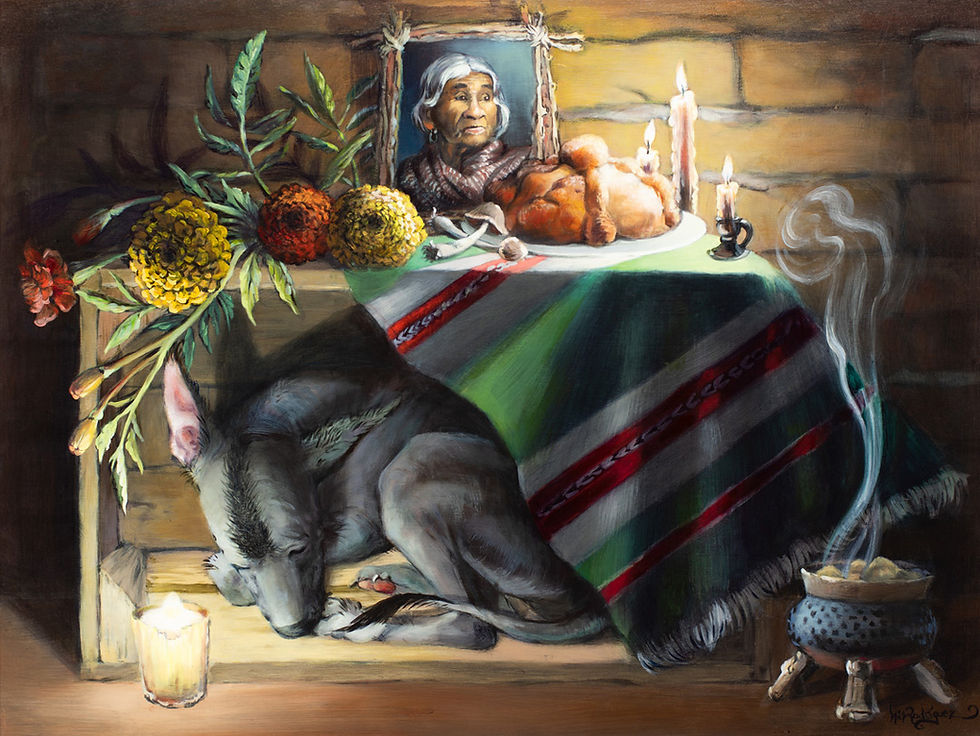HOW CATHOLICISM MADE ME THE ARTIST I AM TODAY PT 1
- Isis Rodriguez
- Dec 15, 2020
- 4 min read
Updated: Jul 9, 2024
Parts of the blog will be included in my very first art book, called, Isis Rodriguez:21st Century Myth Painter. You can obtain your copy here!
This oil portrait called "The Shaman" is my interpretation of a healer, a spiritual warrior or even an Indigenous priest. I created this archetype to promote well being in a polarized world and to create a new narrative for women suffering from shame. It could not have been possible without my religious education. In this blog, I would like to present how Catholicism impacted my vision as an artist.

As a child I attended mass with my family. Everything in a Catholic Church is narrative and symbolic. To begin with, the foundation of the Catholic Church is in the sign of the cross, literally. That is, if you look at the architectural plans from the top view, you will see that the church is located like a cross and inside, you walk through the corridor that leads to the altar and to the left and to the right there are benches.

Its walls are lined with stained glass windows, paintings or statues (in which some tell the story of the 12 Stations of the Cross) and the pews are filled with liturgical books (known as Roman Missals). There is the crucifixion of Jesus on the altar where the priest raises the bread to the cosmos and says: "Through him, with him, in the unity of the holy spirit ..." in which this ritual act is to turn the bread into the body of Christ. Then we go up to receive communion, which is to eat bread, except for those who are not pure, that is, those who have not confessed their sins.
When I went to art school, I took art history from ancient Mesopotamia to the pop art of the sixties. Early artists at that time were responsible for the narrative and it came in the form of mythology. Life was based on survival and mythology was created as the need for humanity to understand the conflicts of their time in the hope of resolving them. In those days, archetypes of mostly divine beings were created who lived their mythology with typical problems that affect humans: rape, births, birth out of wedlock, jealousy between brothers, weddings, wars, murders and resurrections.

I remember being surprised when I found out that the Romans appropriated Greek mythology, in which they changed some of the names of divine gods and goddesses. Then the Christians adjusted them to be martyrs. In the Americas, and in other countries that experienced a Spanish conquest, the Catholic church appropriated a powerful Aztec goddess, Tonanztin, by building churches over her shrine and a known hill called Tepeyac, and renaming her, "Our Lady of Guadalupe" to complete the process of converting the Indigenous into Christians. The first Indigenous saint was Juan Diego, and his legend was first told to me by my grandmother, Lupe, who was born on December 12th, a popular festival honoring Our Lady of Guadalupe. Juan Diego was canonized in 2002, by Pope John Paul II.
Artists went to work for the church to use their skills to recreate the teachings of the Bible and suddenly the mythology became alive. I often wondered what it must have been like to have lived 500 years ago and entering inside a church where it was the social media of it's time.

Christianity began as an activist religion. The main protagonist, Jesus Christ, was a benevolent man who was protesting greed, corruption, prejudice, decadence and self indulgence of the Roman Empire. He had special powers that could heal the sick and he showed compassion to those less fortunate. This ancient social justice warrior has endured two thousand years.

Because so much art history is rooted in belief systems, like organized religion, I've always had the desire to create a new narrative from a spiritual perspective. But what would it look like? Who are the new protagonists? And for what purpose would I dare make such art?
The creation of "The Shaman" was an investigation to design a spiritual being. Living in Mexico has given me opportunities to reconnect with my Mexican heritage. Its spiritual practices has helped me begin a new nature based mythology for the purpose of healing.
I like incorporating old world practices from Europe to the Americas. In the portrait of "The Shaman", we see the burning of copal, sage, and other incense which is a shared practice between the Americas and Europe

"The Shaman" has a tattoo on his stomach that reads, "veni vidi vici", a Latin word for "I came, I saw, I conquered." I think it's important that a healer reveals his power to you because it's reassuring. When we are suffering, we are looking for relief.

Women have undergone centuries of oppression and within the last 50 or so years. We have already seen the changes take action. Western Women now can vote, get educated, access to birth control and to jobs, to name a few. But these new freedoms and rights come with their own set of risks, responsibilities, and issues.
How are we adapting to them spiritually? If religion has been a source of pain instead of joy for some of us, how can we recover? What narrative can be painted to show the evolution from oppression to healing? To be continued at "How Catholicism Made Me the Artist I am Today Pt. 2: Spiritual Manifestations in the Feminine."
By the way, "The Shaman" is available in Limited Edition Giclée Prints. Oh, and before I forget, did you like what you read? Would you like to read more? You can obtain my first art book called, Isis Rodriguez:21st Century Myth Painter.



Comments